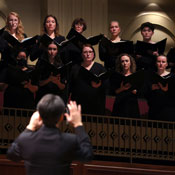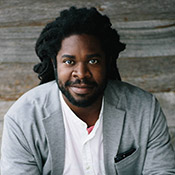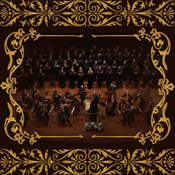
Chorus Members Reflect on 50 Years of Making Music
Abby Vakulskas
PUBLISHED
Tagged Under: 2025.26 Season, Chorus
The 2025-26 season marks the 50th anniversary of the Milwaukee Symphony Chorus, five illustrious decades after founder Margaret Hawkins led its first performance of Hector Berlioz’s The Damnation of Faust with the Milwaukee Symphony Orchestra in Uihlein Hall during the 1975-76 season.
Throughout its early days as the Wisconsin Conservatory Symphony Chorus to its current grandeur as one of the preeminent choral ensembles in the U.S., the MSC has received tremendous praise for its professionalism, versatility, and artistic maturity. It has graced the stages of Carnegie Hall, the Ravinia Festival, and Chicago’s Orchestra Hall, among many others, earning critical acclaim for its performances and recordings alike.
While the chorus has experienced many iterations in its time and has welcomed singers of all ages and walks of life into its fold, a core group has seen the length and breadth of its development. In this golden anniversary year, we spoke with the longest-serving members in each vocal section, who shared their memories of the MSC and their vision for the future of the ensemble.
Bass Jim Sampson and tenor Robert Paddock both joined the chorus in 1976, soprano Sarah Cook came on board in 1981, and alto Donna Stresing joined in 1986 and has served as both a section manager and mentor.
“I feel honored to be in the chorus,” Stresing shares, speaking of the many experiences the ensemble has afforded her. From meeting luminaries like Doc Severinsen, Leonard Bernstein, Marvin Hamlisch, or George Takei, to receiving coaching from a Metropolitan opera specialist or attending free weekly music theory mini-courses made possible by donor support, members are able gain access to the world of professional musicianship while maintaining other careers in their daily lives. Sarah Cook, for example, opted to go into education so music could remain a passion rather than a job. Jim Sampson sees firsthand the restorative properties of music and its power to heal through his work with the Alzheimer’s Association of Southeast Wisconsin.
The MSC provides a unique opportunity where “purpose and passion meet,” he says. “We are teachers, nurses, business owners, retirees — people from every corner of the community — who come together simply because we love to sing.”
“I think it is important to note that most members of the MSC are volunteers,” says Stresing. “As someone who has not studied music, just being in the chorus gives me the opportunity to observe and learn from my chorus mates and directors.”
Make no mistake: though the group is volunteer-based, rehearsals are exacting, with some performance weeks requiring a significant time commitment nearly every evening. Singers must also re-audition biennially to maintain the ensemble’s standard of artistic quality. Yet despite its high expectations — or, indeed, perhaps because of them — the MSC continues to draw loyal members.
“The ever-changing repertoire, the opportunity to perform with the incredible MSO, and continually working to strive for musical excellence are what bring me back year after year,” says Cook. “It’s working with amazing conductors and perfecting the pieces that I find most rewarding.”
All four singers echo this pursuit of excellence as a worthwhile challenge. Margaret Hawkins, they share, set the tone for rigorous practice and perfection of technique, and her legacy has endured through the subsequent tenures of Lee Erickson and Dr. Cheryl Frazes Hill.
“I’ll always remember when they were auditioning new choral directors and wanted to know how we felt about all of them,” says Paddock. “Cheryl worked us hard. And I thought, here is a director who will really push us, and that’s what we need.”
Frazes Hill has succeeded in taking the chorus “to the next level,” says Cook. “I know Margaret is thrilled that her vision of a chorus that was available specifically for the MSO has continued to thrive and flourish.”
This landmark season marks “a marvelous year for choral music,” says Paddock. The ensemble and the MSO will perform multiple masterworks of the choral literature, each of which demand that high level of precision and vocal endurance for which the singers have prepared.
Handel’s Messiah is a common favorite, offering the “perfect mix” of challenge, drama, compassion, and joy, in Stresing’s words. Sampson looks forward to revisiting the monumental epic that is Bach’s St. Matthew Passion and the exhilarating challenge of Beethoven’s Missa solemnis.
“Looking out at the audience during a performance gives the chorus an extra reason to shine,” says Stresing. “Oftentimes, afterwards, a patron will stop us in the gallery or atrium to thank us for a great performance. That simple act of appreciation and kindness means so much.”
Cook expressed gratitude for the large audience that filled the hall for Beethoven’s ninth symphony, the choral opener of the 2025-26 season. “The feeling at the end of each performance as the audience jumped to their feet cheering and clapping is really indescribable,” she says. “Truly, our seats in the choral terrace are the best in the house!”
It is patrons’ continued advocacy that uplifts the chorus’s efforts and bolsters its growth and success — a relationship which is symbiotic with the health of the orchestra.
“Having a well-funded, secure orchestra enables the MSO to program the chorus on a regular basis,” Paddock says. In turn, having an in-house chorus of the MSC’s caliber allows the MSO to program works that could not otherwise be performed: the Masses, requiems, and passions of Bach or Mozart, or the choral symphonies of Beethoven, Mahler, and Vaughan Williams. The same is true for new compositions that require choral dexterity and a willingness to explore fresh repertoire.
“This is such wonderful music that should be shared,” he says. Concerts provide a rare opportunity for audiences to “stop and break from everything and look at how this all fits together — the preparation that goes into it and everyone working as one to create a performance. We’re listening to 300-year-old music and it just…endures.”
“Every time you choose to be present with us, you become part of the experience,” says Sampson. “Nothing can replace the thrill of walking on stage and feeling the energy of the orchestra, the conductor, and my fellow singers. There’s a sense of joie de vivre, a genuine camaraderie in this chorus, that creates bonds that last far beyond rehearsals and performances.”



